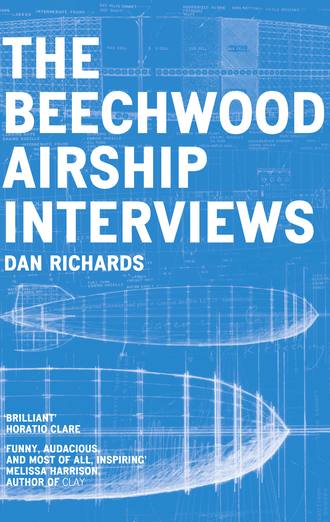
Полная версия
The Beechwood Airship Interviews
‘There’s another thing to this too. My dad was a minister in the Church of Scotland and in 1963 we did an exchange. He took over a church in a small town in North Carolina and the minister from that church worked at my dad’s church in Scotland. We went and lived in their house for three months and they came and lived in ours. Then, in 1993, we went back. It was just for a week or so but my dad was asked to give the sermon in the church there. Now, I grew up seeing my dad give sermons every week, as a kid, and I didn’t think about it, you know? “He’s just my dad.” When I was very young I’d be off into Sunday School by the time he got to the sermon … anyway, my dad was asked by the regular minister to come up and give the sermon, “We have Reverend Jack Drummond here …” and he got up out of the pew and started walking backwards down the aisle and started talking straight away. He got to the front and started going into it and I thought, “My dad’s got an act!” It had never crossed my mind (snaps fingers) and he was really good at it! He had them in the palm of his hand and the guy afterwards, the minister, said, “God, if I could roll my Rs like you, I’d be able to charge X amount more as a visiting preacher!” (Laughs) Which in this country, especially in Scotland, would never be said but that’s how Americans think, and I really learnt something from that. It’s not that I’m trying to imitate my father at all …’
But it’s in you.
‘It’s in me. And I realised I must have taken that in from a very early age − to get up and stand in front of an audience, no amplification, no band. You know, you’re not hiding behind the loud sounds of your guitar or the drums, or everything else, it’s not even that you’re hiding behind a tune. It’s just you and those people there and you’ve got to communicate something and leave something behind.’
You don’t think of yourself as a writer, though?
‘No. I’ve written books but I’m not a writer. I’ve made records but I’m not a musician. I can pick up a guitar or sit down at a keyboard and play some things but I don’t think of myself as a musician, never have done. I don’t think of myself as a writer, don’t think of myself as a painter … I went to art school by accident and I fell in love with painting. I was pretty good at painting too. That’s what I thought I was going to do and then, while I was there, I rebelled against the whole thing. Maybe I realised I wasn’t the genius I hoped I would be but I also thought, and this is going to sound arrogant, “I don’t want to spend the rest of my life attempting to make things to sell to rich people.” You know, one-off things.
I was then beginning to read, as I said, Kerouac and Miller. I liked the idea that with writing you could buy the paperback, everybody could buy the paperback and it was the same everywhere; and the same with music − a seven-inch single. I wasn’t thinking of getting into pop music at that point but I thought − the example I gave myself at the time and remember writing about is that Andy Warhol’s seven-inch of “Penny Lane” by The Beatles is no better or worse than my version. I liked that democracy.
‘So, I walked out of art school, walked away from painting and thought, “Well, I’ll write. To do that, I’ll have to go and live life and do all sorts of jobs, go all over the place.” It’s not like I just wanted to sit down and write novels about relationships and all that kind of stuff. I wanted to get out there into the world and live a life but I realised after a while that I wasn’t really a writer. I don’t know at what point it dawned on me but I was actually doing everything with the head of somebody who’d gone through the British art school system circa early 1970s and that’s still the overriding thing. So the storytelling, doing the posters, coming up with a way of allowing myself to do the paintings all comes from that.’
You say ‘allowing myself to do the paintings’ and you do often seem to structure work around a dogma or set of rules − allowance and denial.
‘It’s not like I’m “into denial” like some sexual or perverse thing … It’s like when I was making three and a half minute pop records; there’s no point making them longer than three and a half minutes. The way that these things are communicated to people is via radio, initially, and radio stations don’t want to play anything longer than three and a half minutes. If it is, they start fading it or talking over it. Also, with a pop record, any record, any recorded music, you can only have it within so many megahertz − you can’t have really high sounds or really low sounds because it can’t exist on a piece of vinyl or an mp3.’
You see a beauty in restriction?
‘Yeah. Like, with oil paints – not that I use oil paints now – you know that this colour and that colour, they can’t mix chemically – so you’re always aware of it.
Doing the posters over the years, I always thought, “Trim it down. Trim it down.” Whereas they started off a lot wordier and there wasn’t much difference between the posters and the writing in the book.’
Are you happy with the term ‘artist’?
‘I’m never happy with that at heart, no, but anything else I try to come up with, it doesn’t work. There was a time when I thought, “No, I’m a poet, that’s what I am, just so happens I don’t use words …” and I tried to convince myself of that but I knew it was even more pretentious and would need even more explaining. There was a period when I was reading more poetry than I was looking at or thinking about art … I don’t know, saying you’re an artist has always had, maybe should have, that pretension. “Oh, you’re an artist are you? That what you think you are? You’re an artist now?” Pop record making was only (holds up thumb and index finger) that much of my life. There was a lot before and after that.’
The advent of The17 seemed to coincide with a shift in popular music away from the single voice to a more choral sound.
‘I think it’s a zeitgeist thing. I think I’m just part of a … this didn’t come into The17 book but I could have started from another point of view:
I buy an iPod. Theoretically, I can have every piece of music that I have ever wanted to listen to on there and I can listen to it when I want. So I get all these tracks and I start flicking through, this one, this one, this one − that’s just me though, jaded − but then I notice my thirteen-year-old doing the same thing, “flick, flick, flick, flick”, or she hears something on an advert, likes it, types it into Google, downloads it − whoosh, she has the band’s whole everything. She doesn’t know what decade they’re from, where they’re from but she’s got it all and maybe listens to it for a week and then it’s gone. Bang.
Next week it’s something else.
‘Something has vastly changed, really hugely changed. When I was a kid, to have an album cost you quite a bit of money. You invested in it. When you got it, if you didn’t like it, you accepted there were maybe only two tracks you liked but you worked at it and you ended up liking it, learnt to like it − that’s not going to happen now, it’s different and I’m not saying anything’s better or worse, it’s just changed. What’s happened since the whole downloading thing has kicked in big time is the live side − going to see the act live is far more important; last year with Leonard Cohen over here − whole generations said, “We’ve got to go and see Leonard Cohen.”
It doesn’t matter if they buy the album …’
It’s the event.
‘The event, yes. Look at the rise and rise of the amount of festivals. It may be a bubble that’s going to burst but it’s now about time, place and occasion – all of those things that I’m dealing with in a different way with The17 – that is what people are going for. It’s no longer contained within the recording.
Some people now, people more of your generation, fetishise vinyl and it’s young people who are buying into a want, a need for music to be more solid, the sleeves bigger …
So those are all reflections of that thing. Of course I hear Arcade Fire and Fleet Foxes and I love it but that’s just me, that’s because of my age and the way it reminds me of things from other times.
I didn’t bring it up this afternoon but I know, over the years, any time I’ve heard choral singing music my ears have gone out to it and that’ll be because I sang in choirs as a kid.’
Perhaps part of the magic of singing in church as a child is that you’re unaware of what you’re singing about.
‘It’s just the sounds, yes, and I’ve read recently how − I can’t remember the composer − he wanted less words, more long vowels and more harmonies because that’s what’s really being communicated. That’s what has the power in religious music. It’s not the words, it’s the sounds, it’s the voices.’
Are you finding that many members of The17 are being affected by the experience?
‘I don’t know. I don’t know enough people … I’ll go and do something like today but I don’t know what the long-term effect is. I’ve got no idea.’
• • • • •
Stoke Newington, London
March 2010
Bill is sitting on his roof − the roof where he writes, weather permitting.
It was here, surrounded by the ambient noise of outer London, that he wrote much of his book about The17*.
Earlier in the day, when I expressed concern that the portrait we’re here to take might look contrived, Bill patiently pointed out that, since he wasn’t in the habit of writing on his ledge with other people looming over him, it was contrived whether I liked it or not and we should probably just make the best of a contrived situation and not worry about it. So we do; Bill with his notebook and tea, Lucy and I teetering precariously above the guttering and the drop, trying to frame the shots.*
We speak about Lady Gaga. Bill loves Lady Gaga; loves her complete ease and ownership of pop. She has compromised nothing, he says, she has created a whole universe and now straddles it, unsurpassed.
Bill tells us that, for a few weeks last year, he and fellow ex-KLFer Jimmy Cauty were in agreement that the only thing which would tempt them back to pop music would be to work with Lady Gaga.
‘Jimmy said he was surprised she’s not telephoned us yet.’
• • • • •
After leaving Bill’s house, I’m struck by the thought that the way he records and narrates his work, however unreliably, may be a stratagem to buttress and bolster its shape – for himself as much as the layman. His world of mad doings only lines up in retrospect when viewed from the justified headlands of 17, How To Be An Artist and the other written records of his work. His books are accepted histories of a lifetime of tangential missions into the unknown and he takes such care to define the narrative path because he knows the chaotic abyss that lurks either side of his stated methodology.
Even the story that there’s no story – no meaning behind a decision – ‘Nothing to see here’, is a sleight of hand way of working.
He generates the story and embodies it, but sometimes his stories are not enough, the wilfulness of his acts too great to be constrained within the books, films, music and statements he makes in their wake – as with THE MONEY – and long shadows threaten to swallow him up … but he writes and talks his way out of it, making something new from the fallout; forms a new plan; invokes a new dialectic and moves on.
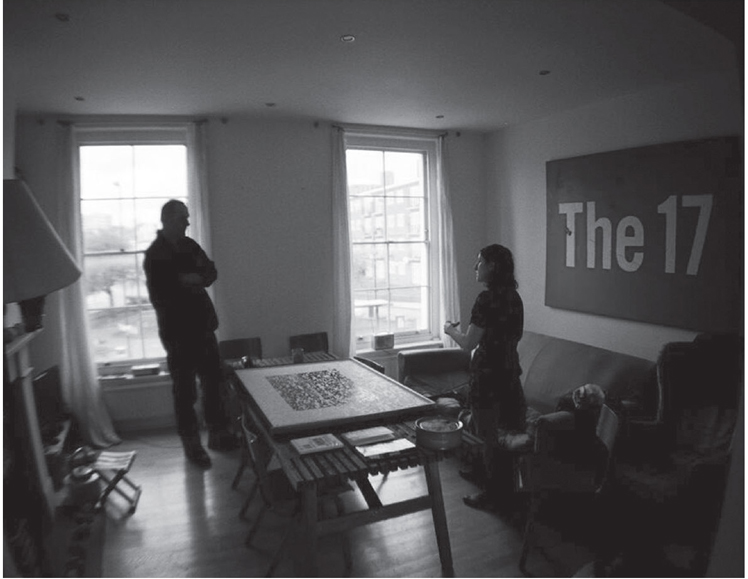
RICHARD LAWRENCE (1958– ) is a British letterpress printer based in Oxford.
He started printing at school in 1970 and bought his first press (a Heidelberg platen) in 1976. As well as commercial printing work, he teaches letterpress and linocut courses at the St Bride Foundation in London.
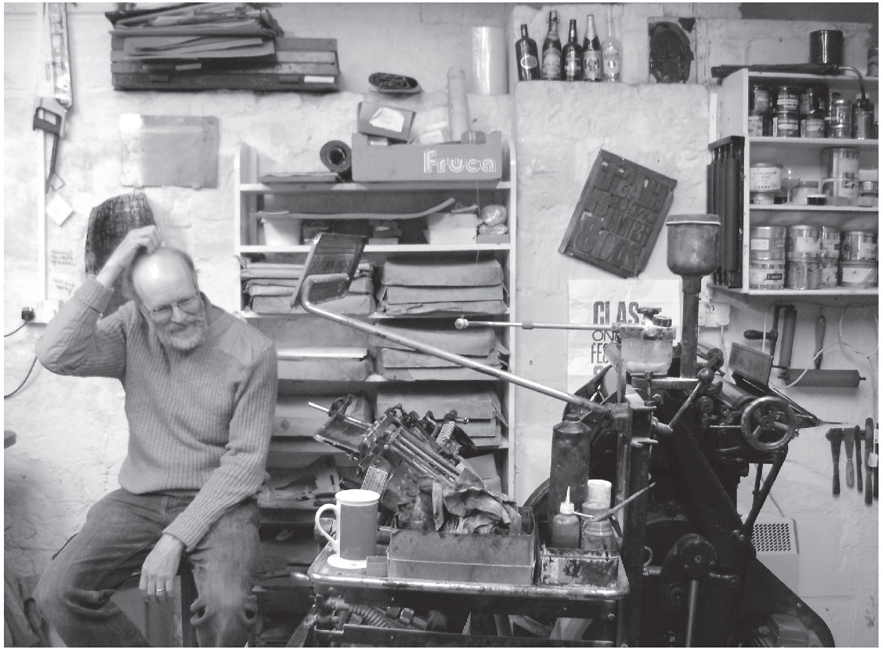
RICHARD LAWRENCE
Widcombe Studios, Bath
2008–2011
Returned home to Bristol from Norfolk, I found myself in a post-MA slump. Unsure of what to do next, I began working on a house renovation, returning life to a wreck, digging retrospective foundations where the Georgians hadn’t seen fit – claggy mud, army boots, two pairs of trousers, early dark starts, insipid rain … it wasn’t much like art school. ‘Well, at least I’m still working with my hands,’ I’d think, dubiously.
After a couple of months, around Christmas 2008, my father told me he’d met an interesting Bath-based letterpress printer who worked with a lot of old kit. I’d written nothing since talking to Bill (I’m not sure I’d even listened back to the tapes). Something about coming home had stumped me and I wasn’t sure where my idea for the book was headed. So I’d stopped. But something about the idea of talking to a printer brought thoughts of the brilliant time had in a Thames boat yard back to mind. I’d known very little about boat building but the craftsmanship and enthusiasm I’d discovered in Henley had inspired and re-energised the whole airship project – my MA too, perhaps – so I telephoned the printer, Richard Lawrence, and asked if I could talk to him about his work. He wasn’t keen, explaining it would likely be very disappointing and tedious for me since what he did was in no way arty, but we arranged to meet in any case after I’d explained that few things could be as disappointing as digging footings with a spade in the freezing cold.
Stood beside the River Avon, Richard’s workshop was a single-storey building with a pitched roof made of corrugated iron but held together with moss.
Mist from the river hung level with the gutters.
I remember the hefty padlock on the garage door was green and its long-term knocking had worn away a hollow in the wood behind it.
The first thing I saw once inside was a print of Fleet Street being consumed by fire and flood – one of a series of linocut visions by Stanley Donwood, an artist with whom Richard had worked for several years; the inky nous to the Donwood dash.*
At the time of my visit they’d recently finished work on a project called Six Inch Records and remnants of the printed sleeves and card inners were piled up on the printshop’s central bench.
Once sat with coffee, Richard explained the division of labour:
‘I do this because I love the machinery and am fascinated by the process of squashing ink onto paper. It’s nice if what you end up producing looks nice but that’s not actually why I do it. (Laughs) I mean, obviously it’s a lot more satisfying to produce something that looks good; and it really doesn’t take any more effort to produce something that looks good than something that looks bad.
Against which it’s very interesting dealing with Stanley. (He points up to a drying rack of prints) Those posters are very obviously made up of broken old wood type. If I had my printer’s hat on I’d go through and replace all the letters that are wonky and fiddle until it all printed solid and so on but that’s not what he wants, he wants it to look like that. That’s why it’s printed on brown paper. (Laughs) It’s rubbish!’
You’re the technician and Stanley’s the artist, then, but where’s the tipping point do you think? What is the difference?
‘In my case, the difference is that I do not have the artistic skill to produce an image that looks nice. So the tipping point between art and straight printing is probably the ability to produce a printing surface that is considered a piece of art. Recently I’ve fallen back on this theory: “I am someone who knows how to put ink on paper” … but it’s very interesting, this distinction between craft and art.
Printing is a design skill, a practical application of common sense.’
Editorial common sense.
‘Exactly. It’s a very difficult dividing line and there’s an enormous amount of expediency in what I do which I don’t think people appreciate. That’s something that Stanley is very good about, actually – he’ll have a vague idea of what he wants but then quite happily bend it or, you might say, be inspired by what’s available. That’s the essence of all the typography that I do. I have an idea of what it would be nice to do and then I think, “Well, what have I actually got with which I could do it?”
‘Somewhere along the way I spent some time at Reading University doing a History of Printing, Design & Typography degree and one of the things that people there say – and it’s very much the way I feel, working with letterpress – is that letterpress is extremely good training for typography and design simply because of the number of things that you can’t easily do. You’re constrained in all sorts of ways and you’re made to work with what there is. It’s a very interesting exercise.
‘A few years ago I had the order of service to do for a funeral and there was a lot of copy in it, a lot of words, and I found I’d only enough of one typeface to typeset the whole thing. You’re then confronted with the problem of how to distinguish all the instructional headings for the congregation, delineate between hymns and pieces of text and, armed with one size of one typeface in roman and italic you can actually produce something that is extremely … I mean, “functional” makes it sound boring but you can produce something that works extremely well and looks good, having started with one option.
If I’d been doing it on a computer it would have been very easy to have as many sizes of type as I wanted and as many fonts but it would have been less thought out – that’s the other constraint with letterpress, if you’re typesetting a lot of material, doing it by hand, it takes a long time and you can’t, at the end of it, say, “Oh, I think it would look better if it was a half a point bigger,” and click a button. It doesn’t work like that. You have to decide before you start what you are doing. It inspires you to plan.’
• • • • •
There are three presses in the printshop proper. An Albion hand-press stands in a corner with an air of solid menace. Next to this a black and chrome press runs the length of the workshop wall – shrouded by a greenish tarp. ORIGINAL HEIDELBERG CYLINDER. 1958. Wheels, handles, dials and levers poke out at intervals, like Dalek punctuation.
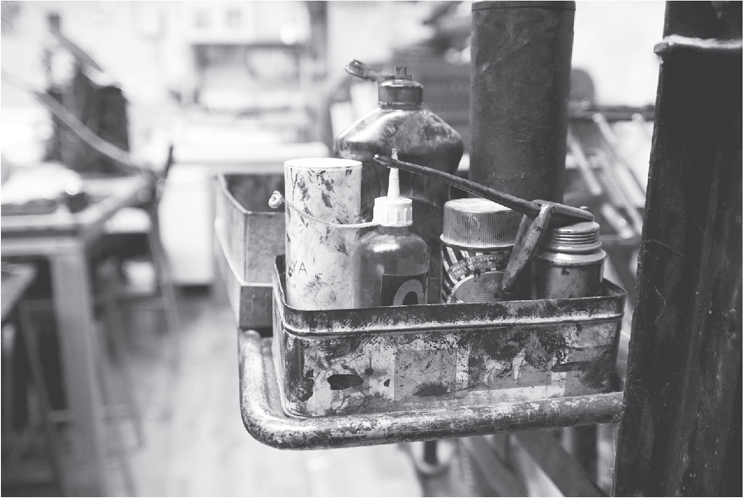
To the right sits HEIDELBERG 1965, a smaller machine which Richard now starts and lets run. As the paper in the feed is fed up to the hinged ink jaw – the myriad movements are crisp and hypnotic – I realise the noise is taking me back to my childhood and the top-left-hand corner of Wales.
‘Pish ti’coo; Pish ti’coo; Pish ti’coo; Pish ti’coo …’
Ivor the Engine reincarnated as a press* and, indeed, all the presses here are substantial, locomotive-like apparatuses – sat still and quiet now but potentially very loud and powerful. Richard resembles a lion tamer sat in their midst.
‘The thing that puts a lot of people off owning one of these is the sheer size – it weighs almost exactly a ton.
Like all letterpress machines, you need an inky surface and a piece of paper and you squash one against the other. That’s it. That’s printing.
This press achieves that by running ink rollers over the surface, and the really clever bit of this machine is the feed mechanism which, rather ingeniously, can suck just one piece of paper up, deliver it to the gripper-arms which then rotate, carrying the paper.’
He hands me a newly printed sheet, the slight indentations of the pressed type just visible if I hold it up at an angle to the light.
‘Most of the trick to running this is knowing how to make it pick up one sheet and not two and not none. What you get good at, after a while, is looking at the pile and listening to the noises the press makes so that, if it does do something wrong, you can very quickly figure out why. You can adjust the number of suckers turned on, you can adjust both the height and strength of the blow that comes through the pile, you can adjust the angle of attack of the suckers, you can adjust how fast the pile is driven upwards and, depending on the thickness of the paper, what height it’s picked from. By adjusting one or all of those things, you can get it to pick up one sheet of anything you want – from very thin paper right up to beer-mat board. Have you ever made balsa wood aeroplanes? They’re done on these, that’s how you print and cut out the pieces for the kits – die cutting. (Rummages through a box file on a shelf by the sink) That’s a cutting die and that’s what it does.’
Richard puts a rectangular piece of wood on the bench. A maze of metal blades project up from it, surrounded by small, close-fitting blocks of foam.
‘The important bit is the shaped cutting rule – it’s quite sharp. If you imagine pushing the die into a piece of card, it would tend to stick in it, so the foam is there to push it apart again.’
Are fold-lines made in the same way but with blunt rules?
‘Yes, the folding rules are rounded on top and very slightly lower than the ones which cut. These are made in Bristol. If you ask people, “What’s printed the most?” the bulk would say newspapers or books when, in fact, it’s packaging material. Cereal packets win hands-down. The vast majority of printing around the world is for packaging and along with packaging comes boxes and for those you need die cutting.’*
Rooting through another box, Richard pulls out a block comprising two interlocking parts. A piece of paper or card placed between these matched male and female dies* will emerge embossed – the design pressed through the page. This is blind embossing, he explains, ‘blind’ because it is an inkless process, the pressure of the press moulding the material into a relief – the definition wrought by the light.
The examples of the practice that he proffers have a wonderfully tactile quality. Fingertips trace the contours of a set of Stanley’s bears – stamped into a furrowed map for a Six Inch Record outer, a linear Braille-scape.
I hadn’t considered printing presses being put to work ‘dry’ in this way. The technique seems so elegant. I ask how Richard cleans his type and presses down.
‘White spirit. You can use paraffin but it leaves a slightly oily residue behind.
One thing I run into which irritates the hell out of me is that the whole letterpress printing thing has been taken over by “creative” people, artists and such, some of whom have, what I consider to be, absurd ideas about safety. There are aspects of this which are clearly very unsafe – don’t stick your head in a moving press; don’t take a handful of lead type and eat it, all that sort of thing – but a lot of people, particularly Americans, are terrified of solvents … and you can get inks that, instead of being based on linseed oil, are based on soya oil; you can use cooking oil or soya oil to clean down the machinery afterwards, you can … but it leaves it in the most foul, sticky, gunky condition – if you know what you’re doing, washing a machine up with white spirit, you’ll perhaps use two fluid ounces.’
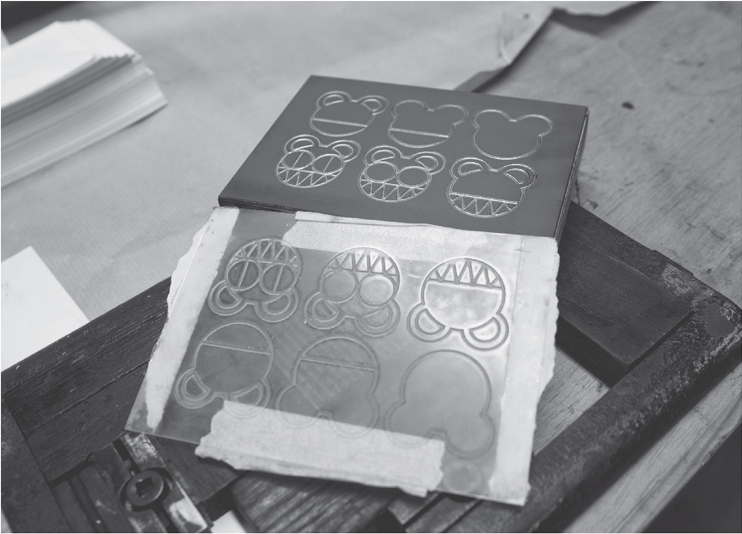
Can you tell me a bit about your inks?
‘Oh, they’re all boring old linseed oil based inks – you take linseed oil and boil it, then grind pigment into it. I don’t personally do that, there’s an ink making company in South Wales who treat me extremely nicely. I started using them some while ago. I asked them, “Could you possibly, maybe … ?” and they said, “Oh yes, not a problem,” and now they produce six different pots of bespoke colours for about £20 apiece which was about a third of what I’d expected to have to pay. I subsequently looked them up on the internet and they turn out to be Britain’s major ink producers – they’re the people who supply Fleet Street – so what they’re doing piddling around producing pots of obscure colours for me I’ve no idea; but I love them for it.’
Richard crosses over to a shelf, takes a lid off a tin and holds it out. Inside the ink resembles emerald engine grease – sickly, fat and viscous.
‘Here is a tin of green that I bought the other day.’


